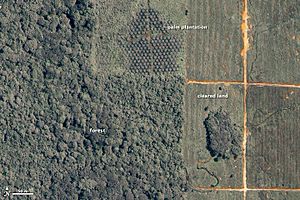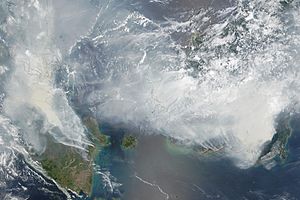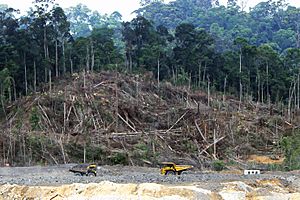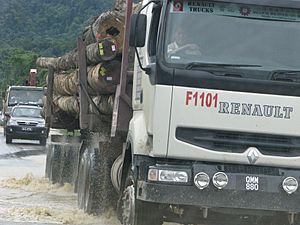Deforestation in Borneo facts for kids
Deforestation in Borneo means that many forests on the island of Borneo have been cut down. This has been happening on a very large scale since the 1960s. Borneo is the third largest island in the world. It is shared by Indonesia, Malaysia, and Brunei. This island was once covered by thick tropical forests.
In the 1980s and 1990s, the forests of Borneo were cleared faster than ever before. They were burned, logged, and often replaced with farms. This cutting down of forests continued into the 2000s, but at a slower speed. More and more palm oil farms were also created. About half of all tropical wood bought globally comes from Borneo. Palm oil farms are quickly taking over the last parts of the original rainforest. Much of this forest clearing is against the law.
The World Wildlife Fund divides Borneo into different natural areas. These include the Borneo lowland rain forests, which cover most of the island (about 427,500 square kilometres (165,100 sq mi)). There are also Borneo peat swamp forests, Kerangas (heath forests), freshwater swamp forests, and Sunda Shelf mangroves. The mountain rainforests are in the central highlands, above 1,000 metres (3,300 ft). These areas are home to many endangered species. For example, orangutans, elephants, and rare animals like the Hose's civet live here. The Bornean orangutan has been a critically endangered animal since 2016.
Borneo's forests are very important for protecting different kinds of plants and animals. They also help to store carbon, which slows down global warming. The forests are also important for local people. They help them get clean water and enough food.
Contents
Why are Borneo's Forests Disappearing?
The main reasons for deforestation in Borneo are logging (cutting down trees for wood), turning forest land into farms (especially for palm oil), and forest fires.
Logging for Wood
In the past, not many trees were cut down in Borneo. This was because the soil was not very good, the weather was difficult, and there were diseases. Serious deforestation only began in the mid-1900s. Large-scale logging started in the 1970s. This happened as Malaysia ran out of forests on its main peninsula. In Indonesia, the government also allowed a lot of logging to happen.
Logging grew a lot in the 1980s. New roads built for logging helped people reach faraway lands. This made it easier for settlers and developers to clear more forest. Logging in Borneo in the 1980s and 1990s was some of the most intense in the world. Much more wood was taken from each area compared to places like the Amazon. By the late 1980s, both Indonesia and Malaysia faced a problem. They were cutting down trees faster than new ones could grow.
Palm Oil Plantations

Palm oil is used in many products, from food to cosmetics. To grow palm oil, large areas of forest are cleared. This has become a major reason for deforestation in Borneo. Many palm oil plantations are built on land that used to be rainforest.
Forest Fires
Most fires in Borneo are started to clear land. While the Indonesian government often blamed small local farmers for fires, studies show that large companies are the biggest cause. They start fires to clear land for farms, especially palm oil plantations. This was a big reason for the famous fires in 1997–1998.
Today, fires are still set every year to clear land for farming. When the weather is dry, these fires can easily spread into nearby forests. They can then burn out of control. These fires are happening more often and are getting worse. This causes problems between countries in the region. Nearby countries like Malaysia and Singapore blame Indonesia for not controlling the fires. Indonesia, in turn, says that Malaysian companies start many of the fires to clear land.
Borneo's Different Regions
Borneo is divided into parts belonging to Malaysia, Indonesia, and Brunei.
Malaysian Borneo
The Malaysian states of Sarawak and Sabah are in the north. They make up about 26% of the island. The forest here quickly got smaller because of heavy logging for the Malaysian wood industry. In the early 1980s, researchers found fast-growing trees like Acacia mangium and Gmelina arborea. These trees were planted on huge areas that had been logged or cleared.
Indigenous peoples (native communities) in Malaysia have been affected by logging. Trees were cut down in their traditional forest lands without their permission. These communities have used peaceful protests, social media, and blockades to show their rights to the forest. They have had some success. However, questions remain about how logging permits were given without the communities agreeing.
The rainforest was also badly damaged by huge forest fires from 1997 to 1998. Locals started these fires to clear forests for crops. An unusually dry El Niño season during that time made the fires much worse. During these big fires, hot spots could be seen from satellites. The haze (thick smoke) from these fires affected nearby countries like Brunei, Malaysia, Indonesia, and Singapore. In 2008, the Malaysian government announced a plan called the Sarawak Corridor of Renewable Energy. This plan aims to use the resources in the untouched areas of northern Borneo. More deforestation and harm to nature are expected from logging, dams for electricity, and mining.
Indonesian Borneo
About 73% of Borneo is Indonesian land. The Indonesian name for the island, Kalimantan, is often used to talk about the Indonesian part.
To help with too many people in Java, the Indonesian government moved many poor farmers to Borneo in the 1970s and 1980s. This was to farm the logged areas. But it did not work well. The soil lost its goodness when the trees were removed. Any soil left was washed away by heavy tropical rains.
The Mega Rice Project
The Mega Rice Project started in 1996 in southern Kalimantan. The goal was to turn one million hectares of "unproductive" peat swamp forest into rice paddies. This was meant to help with Indonesia's food shortage. The government spent a lot of money building canals and removing trees. But the project failed and was stopped after causing much damage to the environment.
The peat swamp forest in southern Kalimantan is a special kind of natural area. It is home to many unique or rare animals like orangutans. It also has valuable trees that grow slowly. A peat swamp forest is a special ecosystem. It has many different tropical trees growing on a 10 to 12 meter layer of peat. Peat is partly decayed and waterlogged plant material. This peat layer covers soil that is not very fertile. Peat stores a lot of carbon. If it is broken down and burned, it releases CO2 into the air. This CO2 is a gas that contributes to global warming.

The canals, roads, and railways built for legal logging also made it easier for illegal logging to happen. In the Mega Rice Project area, forest cover dropped a lot between 1991 and 2000. It has continued to decrease since then. It seems that almost all the valuable trees have been removed from these areas.
It turned out that the canals drained the peat forests instead of watering them. Before, the forests often flooded up to 2 meters deep in the rainy season. Now, their surface is dry all year. The government stopped the project. But the dry peat can easily catch fire. These fires continue to break out on a very large scale.
After the draining, fires destroyed the area. They burned the remaining forests and wildlife, along with new farms. This filled the air over Borneo and beyond with thick smoke and haze. It also released huge amounts of CO2 into the air. This destruction badly affected the lives of people in the area. It caused major health problems for half a million people, who suffered from breathing issues because of the smog.
Destroying peat forests also causes acidic water pollution in the rivers. In the rainy seasons, the canals release acidic water into rivers up to 150 km upstream from the river mouth. This might be a reason why fewer fish are being caught.
A study in 1998 suggested that about 40% of the wood in Indonesia was illegal. More recent estimates suggest that 88% of logging in Indonesia is illegal in some way. Malaysia is a key country where illegally logged wood from Indonesia passes through.
What is Being Done?
There is a need for better ways to manage the forest's resources, especially logging. But to make this happen, we must understand that protecting the forest is not just up to Indonesia and Malaysia. It is not fair to expect a few countries, even if they have many debts, to protect most of the remaining rainforest by themselves. Protecting the rainforest is a global effort. This effort will also help solve the development problems that Indonesia and Malaysia face with the Borneo rainforest.
Reforestation Efforts
Recently, a reforestation project in East Kalimantan has shown some success. The Borneo Orangutan Survival Foundation (BOS), started by Dr Willie Smits, bought almost 2,000 hectares of deforested land in East Kalimantan. This land had been damaged by logging, dry weather, and severe fires. It was covered in a type of grass called alang-alang. The goal was to bring back the rainforest and create a safe home for orangutans that had been rescued. At the same time, it aimed to provide jobs for local people. The project was named Samboja Lestari, which means "everlasting conservation of Samboja." Reforestation and helping the land recover are the main parts of the project. Hundreds of local tree species have been planted. By mid-2006, more than 740 different tree species had been planted.
In the Lamandau Wildlife Reserve, the Orangutan Foundation has planted over 60,000 young trees. This is part of their Forest Restoration Programme. These young trees were planted to bring back the forest and help areas damaged by fires.
See also
 In Spanish: Deforestación en Borneo para niños
In Spanish: Deforestación en Borneo para niños




